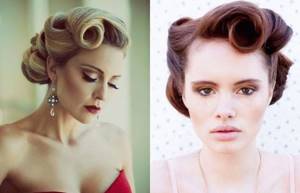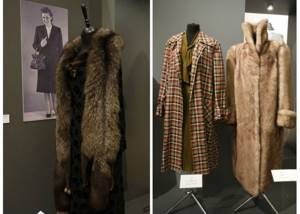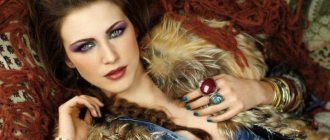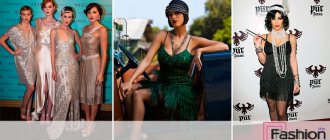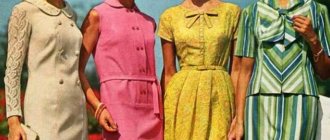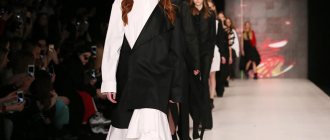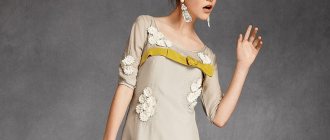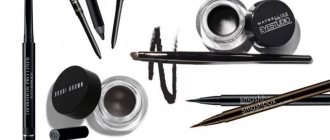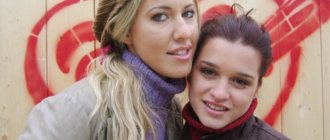The 40s did not bring the long-awaited relief after the difficult 30s. The Great Depression gave way to World War II, which ultimately led to many social upheavals. The development of women's fashion was dictated by harsh circumstances, so during this period its own special women's line of images was born, which we can sometimes see in the modern world
The main features of clothing style in the 40s
Style of clothing
Due to the restrictions introduced, all the clothes were not full of abstruse and complex styles. Laconism and simplicity are the main indicators of clothing of that time. Craftsmen were forbidden to sew flared skirts and dresses, but only fitted ones without pleats. Jackets for women were square in shape and resembled those for men. The belts were sewn like army ones, and the blouses had gathered sleeves.

Headdress
Wide-brimmed hats were used as headdresses, which helped hide women's untied hair, as many manufacturers had discontinued the production of hairpins. Hats and bold styles of turbans were on sale.
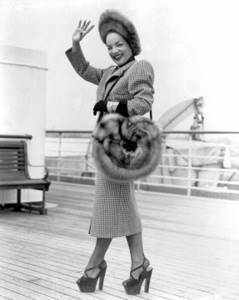
Shoes
Instead of leather shoes, shoes with cork and thick soles came into fashion. These shoes were quite comfortable and were very popular.
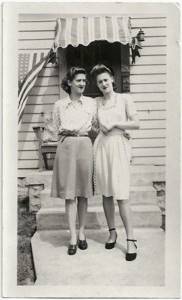
How to Create a 40s Look
To create a themed look, follow the advice of stylists:
- The styles are laconic and discreet.
- Wide shoulder line, use of shoulder pads.
- Skinny, knee-length pencil skirts.
- Shirt dresses with patch pockets
- Minimum decorations and decor.
- No ruffles, lace, frills, bows.
- The waist is accentuated by a massive belt.
- Clothing in soft colors.
- Prints include checks, polka dots, stripes, small flowers.
- High-waisted wide-leg trousers and overalls.
- White cuffs and collars.
- Shoes with cork wedges or low heels.
- Nylon stockings.
Even in difficult times, women try to highlight their beauty through clothing. Many post-war fashion styles are still popular today.
Occupied France and the popularity of fashion in the USA
When France was occupied, it ceased to be a trendsetter, as before. Many residents began to introduce their own methods of creating an image into fashion, and the couturiers were not at a loss and created unique trends that were later appreciated by the whole world.
Don't miss: The most fashionable bags fall-winter 2021/2022 (50 photos)
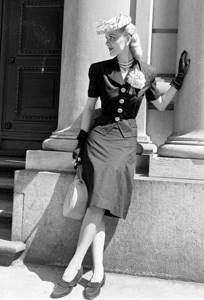
It was a casual Californian style, businesslike and collegiate. Fashion includes practical items made from wool jersey and cotton fabric, which is widely accepted by society.
In modern fashion
The retro style of the 40s, with its asceticism and femininity at the same time, remains a shining example of elegance. The lines and silhouettes of the dresses of that time were emphatically simple, but extremely sophisticated and practical. A minimum of fabrics are used, but all elements of clothing are thin and airy. Deep necklines, graceful lines of pencil skirts, simple buttons on jackets, thin straps that emphasize the waistline and elegance are all details of military era fashion.
The 1940s style became a trend, repeating the lines and patterns in the collections of many famous designers during the fall/winter seasons 2009-2010 and 2011-2012. Gucci, Prada, Jean Paul Gaultier, Donna Karan turned to elegance, which sought to emphasize the fragility of the weaker sex. Spring/summer 2013 saw a revival of 1940s fashion: straight lines and silhouettes, high collars on shirts and jackets, long pencil skirts and functional shirtdresses reappeared.
Source
Revival of French fashion
In 1944, when France was liberated, new designers entered the Haute Couture arena and presented a new collection of fashionable clothing, showing it to the whole world. In 1947, Christian Dior introduced his first collection into fashion, once again reviving the fitted corset and full skirts.
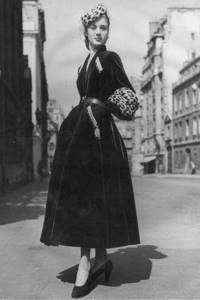
Women's wardrobe of the 40s
Fashion in the 1940s was subject to strict wartime requirements. Thick fabrics were often used for sewing clothes. Shirt dresses and women's white shirts of a simple cut have become popular.
The dresses had a sporty cut, a row of buttons to the waist, a narrow skirt with several pleats at the back, ruching at the waist, shirt-style sleeves and cuffs. A common silhouette: wide shoulders, a belted waist and narrow hips. Shoulder pads and belts with buckles were used. One product could combine several shades and different types of material.
Festive outfits were distinguished by femininity, had a flared skirt, folds, gathers, and draperies. Sundresses and overalls, under which a shirt or sweater was worn, became popular.
Sundresses and skirts were complemented with jackets. Outerwear had a militaristic look. Short single-breasted or double-breasted coats were considered relevant.
At the end of the decade, corsets, voluminous long skirts, blouses with loose sleeves and flounces returned to fashion. Christian Dior became a popular designer. Creating romantic outfits, he returned grace, femininity, and elegance to clothes. The collections quickly sold out.
Shoes in the 40s
In the 40s, leather was in great short supply, so the top of the shoes was made of textiles, and wood or cork was used as the sole. Nowadays, factories could easily purchase Ivanovo textiles in bulk at excellent prices. It was not possible to make heels, since metal had to be used, so platform or low-top shoes were in fashion.
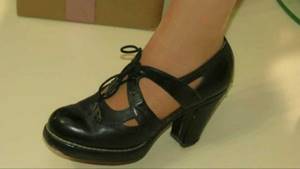
The most popular color was black, as it was considered the most practical. It was easy to match with different clothes and it was more difficult to get dirty. But brown, beige, blue, red and other colors of shoes could also be found on sale.
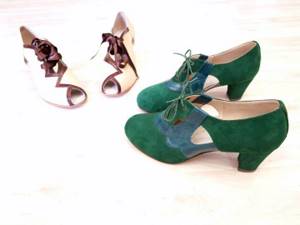
Fashion history: 40s
Unique fashion of the 40s. At this time, fashion was dictated by the difficult conditions of the war and post-war times and the extreme limitations of materials. Nevertheless, people, even in such troubled times, wanted and managed to remain beautiful.
What is forties fashion? “Modesty and emphasis” - this is how the trends of the 40s were designated. In the first half of the decade, embellishments and flares went away and were replaced by a straight straight skirt or a knee-length A-line skirt. Such a strict style of clothing was dictated by a simple lack of fabric. The wardrobes and demands of fashionistas were very modest. The military style was evident throughout; some clothing details could be used in both men's and women's suits. For example, blouses of that time were similar to ordinary shirts. Jackets had square shoulders, jackets always had padded hangers, the shoulders seemed wide and square, and the waist was highlighted with a belt or strap.
Shoes then were worn with high thick heels, pumps or platform shoes. Sandals were very popular, but those who liked to dress in the old fashioned way wore retro shoes - oxfords.
Only rich, stylish women could afford nylon stockings, because at that time nylon products were very expensive. It got to the point that women who were unable to buy stockings would add seams and heels to their bare legs. Accessories included a small hat and a bag - a reticule.
It became a little easier in the second half of the forties. Clothes remained in restrained tones; gray-blue, muted green, and brown colors were used more. Young people, of course, liked products made from fabrics with polka dots or checkered patterns. Many trophies were brought from liberated Europe, including clothing. In addition, since 1945, fashion has been greatly influenced by items as humanitarian aid from our ally, the United States of America. It was then that brighter colors began to come into fashion, shorter skirts for sports and leisure, and not such modest styles as we were used to: puffed sleeves and wings, decorative buttons, unusually cut collars, wider skirts - everything that would come later based on 50s fashion.
Colored fabrics and fabrics with patterns were sold out in stores at the speed of light, regardless of price. Dresses made from them looked very beautiful (velvet was especially fashionable).
At that time, you could give a girl a piece of good Baltic fabric and seriously win her favor. And this is not a joke, because it was practically impossible to get such cuts; all this was for the elite, for the elite of society, wives of officers and political leaders of the country. At this time, even for the “highest” class, proof of “status” was the presence of a boa or cape made of silver fox. Women with low incomes did not disdain cat fur trim.
Special mention should be made of the modest designer, the great couturier - Christian Dior. The heyday of his creativity coincided with this difficult period. The maestro experienced poverty and all the hardships of the fascist regime, but, nevertheless, was able to break through and grow into a powerful tree - the House of Haute Couture Dior.
Dior's models have always had a special charm. Christian himself called it NewLook. Romantic line, with a new version of crinoline, thin waist and fitted bodice. In this silhouette, he embodied his own idea of femininity, which was so lacking during the war era with its uniforms and “labor conscription” for women. What is characteristic is that Soviet society did not immediately accept the NewLook direction - it took exactly 10 years for Christian Dior’s models to enter the everyday life of women in the USSR in 1957.
Thanks to its laconicism, restraint, severity and at the same time femininity, the fashion of the 40s is still relevant today.
Pay attention to the main features of fashion of the forties.
Midi length.
A-line or straight skirt.
Simple, sleek silhouette.
Emphasis on details: collar, cuffs, flaps on pockets and sleeves, pleats, buttons, belt or belt emphasizes the waist.
Colored prints in combination of all of the above.
Natural fur is often used as a decorative material.
As for shoes and the style of wearing them, it is impossible not to notice the spirit of the past in the trendy models of modern designers.
Why was it so then, why is it relevant now?
Time dictates its own rules. The 40s brought difficult trials, women took on the hard work of men, they fought equally with men, they looked death in the face every day. But they did not cease to be women dreaming of love, family, children. So, by shortening their skirts and narrowing them just enough to allow for a step, choosing subdued colors that were more practical for 18-hour workdays, women got creative in emphasizing their femininity. Of course, now is not such a difficult time, but a woman in the modern world takes an active position in life - she works, holds leadership positions, takes care of her family, plays sports, and travels. She is strong, purposeful and at the same time feminine and attractive. Women of the 40s and our contemporaries have something in common. Perhaps this is why in fashion trends there is a return to the ideas of war and post-war times.
Women always remain beautiful, despite all the difficulties they have to face and no matter what time they live in. Ingenuity and the desire to be noticed will stop the female sex at nothing.
Types of hairstyles
For Soviet people, the most important art has always been cinema. Therefore, it is not surprising that film actresses immediately became trendsetters. Including hairstyles.
For example, the film “Babette Goes to War” with Brigitte Bardot in the title role was released. And Soviet ladies immediately wanted such a hairstyle. The more voluminous the better. Some even added additional materials so that there was something to attach the fleece to.
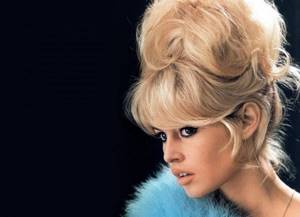
Also trendsetters were the French actress Mireille Mathieu and the domestic “diva” Lyubov Orlova. For many years, Orlova’s curls became the generally accepted standard in all Soviet hairdressing salons.

And during the Thaw, when Western fashion magazines began to filter into the country, hairdressers had to learn to experiment. So the hairstyles of the USSR were about 5 years behind what was fashionable in the West. And they were somewhat simpler, since colleagues were in no hurry to share the secrets of hairdressing.
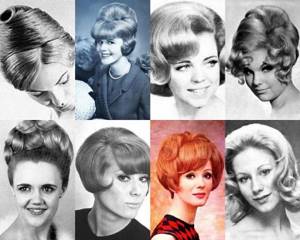
We also believe that you would be interested to know about some of the products that literally became the “symbol” of the USSR. And whatever you say, their quality was at an extremely decent level, especially considering the price.
Short hair in the forties
In the 40s, both short and long hair were also allowed. For example, small curls were created from short hair, for which the hair was curled with small curlers and then carefully combed so that the curls did not break. We tried to create curls as small as possible, no more than 2 cm in diameter. In order for the curls to last as long as possible, they were slightly moistened beforehand, and after curling they were attached to the root zone with hairpins.
Small curls were created mainly on short hair, because medium and especially long hair cannot maintain the shape of small curls for a long time: they fall off under their own weight.
By changing the direction of the curls, their diameter and location, you can add variety to this style. As a rule, it takes a lot of time to create small and strong curls: this hairstyle cannot be done within an hour. Therefore, women curled their hair in curlers in the evening and slept on them all night. Such a heroic feat was required in the name of beautiful styling!
Second half of the 40s: “Trophy fashion”
Items from soldiers' duffel bags become symbols of a beautiful life: captured furs, German leather gloves, Polish hats. Tired of military everyday life, gray padded jackets and sheepskin sheepskin coats, women do not spare money on expensive outfits; fur products are especially popular. Those who are richer buy “prestigious” cats and astrakhan fur in second-hand stores, the middle class is content with rabbit fur coats and squirrel collars.
Outfits brought by Soviet soldiers from Germany as gifts to wives and mothers |
For men, the military style is in fashion and the image it creates of a winner, a stern defender of the Motherland: shoulder straps, double-breasted leather coats, wide turn-down collars and thick trench coats.
From left to right: writers Alexei Tolstoy, Konstantin Simonov, Ilya Erenburg and security officer Dmitry Kudryavtsev |
Are you in a hurry? Very good
Having returned to fashion today, wartime hairstyles forced hairdressers, and fashionistas, to be as creative as possible. So, now the trend is deliberate carelessness of styling, asymmetry, protruding “roosters”, which were simply unacceptable before! And also the volume that comes straight from the roots of the hair, a combination of several different braids, each with complex weaves.
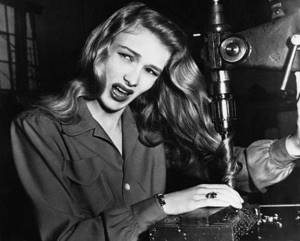
At the same time, the braid should look as if you braided it in a big hurry. Or they fell into bed at night and didn’t even go to the mirror in the morning.
There are many hairstyle options. This is a braid coming from the tail, and a tourniquet, and a “spikelet”, and a “fishtail”, and many, many more things that your imagination is capable of.
Conclusion
So, hairstyles in the style of the forties are a great option for both everyday life and retro parties. The degree of imitation is determined by the environment.
- So, for the office or for walks, part of the Victory Rolls style is suitable: a roller on the bangs.
- For a retro party, you can completely imitate the style of those years, from hairstyle and makeup to clothes and shoes.
- At some costume carnival, you can appear in the style of the American poster “We can do it” or some American actress who was popular in those years.
You will definitely attract admiring glances, and your girlfriends will beg you to teach you how to style your hair in such mysterious and romantic retro rollers.
40s style dresses: key features
A working woman had to spend the whole day behind a store counter, in an office, at a school board, or at a factory machine. All these circumstances and the need to devote oneself to providing for one’s family in difficult times of war led to a simplification of styles and the emergence of practical and comfortable silhouettes.
The key features of 1940s retro fashion for dresses can be considered the following:
- Pronounced waistline. A practical wardrobe detail - a belt or cummerbund - made it possible to securely secure an outfit. Almost all dresses of that time were secured at the waist using straps, buttons, hooks, clasps or darts.
- No full skirts. Due to the total shortage of materials for the production of fabrics and finished products, in many countries, at the legislative level, a decision was made to change the styles of finished products in order to reduce the consumption of materials by 1 unit. The lower part of the dress was not fluffy, but also did not resemble a pencil style, only slightly widening towards the bottom, reminiscent of a trapezoid.
- Extension of the shoulder line. In order to make the figure more proportional, and to comply with the mood of the masses in wartime, designers increased the width of the shoulder line with the help of shoulder pads, giving the female figure an hourglass silhouette and at the same time made the dresses of 40-45 look like a military uniform.
- The length of the finished product is to the middle of the knee or slightly below.
- The sleeves were dominated by short lantern style or long flared ones. The absence of sleeves on dresses in the style of the 40s was noticeable among evening models and was almost completely absent in everyday fashion.
Modern haircuts and styling options
On short curls, you can recreate retro hairstyles with textured curls. Smooth, neat waves emphasize regular, elongated, triangular ovals. Recommended for young ladies with expressive eyes and regular facial features. Suitable for creating evening looks, goes well with cocktail and evening dresses, feminine, elegant tuxedos.

The average length allows you to embody various ideas. A simple, but no less effective option is loose curls, twisted into soft curls. Combined with a side parting, the hairstyle is characterized by the absence of bangs. The volume is evenly distributed along the entire length. Stylish styling is suitable for young ladies with curvy figures, a chiseled silhouette, and will add femininity and elegance to sporty girls. Universal styling is suitable not only for special events, it can be used for business style, and is also appropriate for a romantic date.
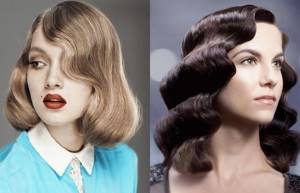
The characteristic curls are carefully fixed with hairpins and bobby pins. A hairstyle that is quite complex to do on your own requires professional skills. It can be created for medium and long curls, the hair is neatly collected in a bun at the back of the head. Will decorate slender, tall girls with harmonious facial features. The hairstyle opens the line of the neck and shoulders; it is recommended to combine it with open outfits, as well as vintage dresses.
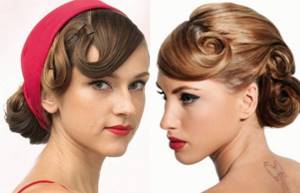
High symmetrical rolls became the hallmark of that time. Today, such options can only be used for themed parties. Playful images are not associated with the war period; in a modern interpretation, they are complemented by bright outfits and accessories.
Important point! Thanks to the volume in the crown area, the hairstyle visually harmonizes round and square ovals, focusing maximum attention on the face. It is recommended to combine with bright but natural makeup using natural shades.
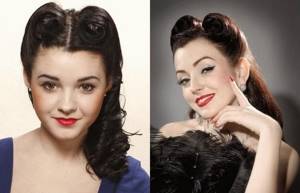
Collected strands at the temples emphasize the consistency and elegance of the image. The symmetry of the hairstyle suits young ladies with classic beauty and regular features. The model is performed on medium and long curls, straight structure. You can combine it with loose, curled strands at the back of your head or gather your hair into a neat bun.
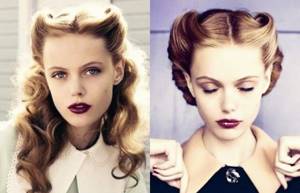
A high curl in the forehead and large waves along the entire length look impressive on long curls. They are chosen by young ladies who want to emphasize femininity and attractiveness. Impractical to style as a daily option, this beautiful model is appropriate for special occasions, celebrations, receptions, and exhibitions. You should approach the choice of outfit and accessories no less carefully; you should continue the general concept of grace and elegance.
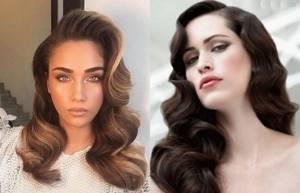
Roller-curled bangs are a characteristic element of the 40s style. An open forehead made it possible to visually harmonize round, wide faces. The hairstyle gave special prettiness to elongated and triangular ovals. It is recommended that young ladies choose a playful hairstyle in a modern interpretation for retro parties, combining it with bright outfits and evening makeup.
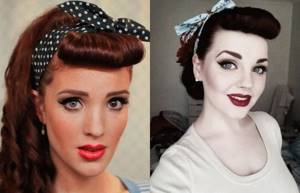
Skillfully styled large curls turn girls into real film stars. Collected curls open the shoulders and neck, and at the same time have correction properties. Hairstyles created specifically for balls and special events. Can be combined exclusively with luxurious floor-length evening dresses.
